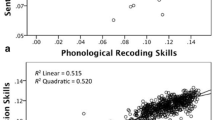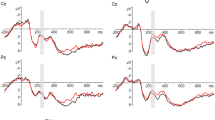Abstract
The aim of this study was to elucidate the word decoding strategies of Hebrew readers with prelingually-acquired, severe hearing impairments as opposed to regular Hebrew readers, and to determine their efficiency. The research paradigm used to clarify these issues asked participants to perform a sequence of three learning tasks, calling for the association of digits with (1) written Hebrew nouns, (2) with pseudo-homophones (PH) of these nouns, and (3) with nonsense words (NW) comprised of the same graphemes as the nouns. Ninety-two secondary school students, half of them hearing impaired (HI), performed the tasks in succession, with the word/digit association task (the primer) always being administered first. For two sub-groups, however, comprised of approximately half of the members of each of the groups, the order of the latter two tasks was reversed. As such, 23 of those who were HI and 24 of those who were not performed the PH/digit association task after the word/digit association task (primed), whereas for the remainder (unprimed), the word/digit association task was immediately followed by the NW/digit association task. It was expected that, for hearing readers but not for HI readers, the existence of homophony between the real words and the PH’s in the primed condition would facilitate learning associations for the latter. This hypothesis, however, was not confirmed. Neither of the two primed groups exhibited sensitivity to homophony. This finding is particularly surprising with respect to the primed hearing group, since it totally contradicts current popular theories that assign phonology a central role in the processing of written materials by unimpaired readers.
Similar content being viewed by others
References
InstitutionalAuthorNameAmerican National Standards Institute (1989) Specifications for audiometers (ANSI S3.6-1989) ANSI New York
A.D. Baddeley (1986) Working memory Clarendon Press Oxford
A.D. Baddeley N.C. Ellis T.R. Miles V.J. Lewis (1982) ArticleTitleDevelopmental and acquired dyslexia: A comparison Cognition 11 185–199
A.D. Baddeley S. Gathercole C. Papagno (1998) ArticleTitleThe phonological loop as a language learning device Psychological Review 105 158–173
U. Bellugi E. Klima P. Siple (1975) ArticleTitleRemembering in signs Cognition 3 93–125
S. Bentin I. Raphiq (1996) ArticleTitleNew evidence for phonological processing during visual word recognition: The case of Arabic Journal of Experimental Psychology: Learning, Memory, and Cognition 22 309–323
J.D. Bonvillian (1983) ArticleTitleEffects of signability and imagery on word recall of deaf and hearing students Perceptual and Motor Skills 56 775–791
B. Byrne R. Fielding-Barnsley (1993) ArticleTitleEvaluation of a program to teach phonemic awareness to young children: A 1-year follow-up Journal of Educational Psychology 85 104–111
G. Coles (2000) Misreading reading: The bad science that hurts children Heinemann Educational Books Inc. Portsmouth, NH
R. Conrad (1979) The deaf school child Harper & R London
L.C. Ehri S.R. Nunes S.A. Stahl D.M. Willows (2001) ArticleTitleSystematic phonic instruction helps students learn to read: Evidence from the National Reading Panel’s meta-analysis Review of Educational Research 71 393–447
R. Frost (1998) ArticleTitleToward a strong phonological theory of visual word recognition: True issues and false trials Psychological Bulletin 123 71–99
V.L. Hanson (1982) ArticleTitleShort-term recall by deaf signers of American Sign Language: Implications of encoding strategy for order recall Journal of Experimental Psychology: Learning, Memory, and Cognition 8 572–583
V.L. Hanson (1989) ArticleTitleRecall of order information by deaf signers: Phonetic coding in temporal order recall Memory and Cognition 18 604–610
V.L. Hanson C.A. Fowler (1987) ArticleTitlePhonological coding in word reading: Evidence from hearing and deaf readers Memory and Cognition 15 199–207
V.L. Hanson E.W. Goodell C.A. Perfetti (1991) ArticleTitleTongue twister effects in the silent reading of hearing and deaf college students Journal of Memory and Language 30 319–330
V.L. Hanson E.H. Lichtenstein (1990) ArticleTitleShort-term memory coding by deaf signers: The primary language coding hypothesis reconsidered Cognitive Psychology 22 211–224
V.L. Hanson N.S. McGarr (1989) ArticleTitleRhyme generation by deaf adults Journal of Speech and Hearing Research 32 2–11
V. Kelly (1995) ArticleTitleProcessing of bottom–up and top–down information by skilled and average deaf readers and implication for whole language instruction Exceptional Children 61 318–334
A. Koriat (1984) Reading without vowels: Lexical access in Hebrew H. Bauma D.G. Bouwhuis (Eds) Attention and Performance X: Control of Language Processes Earlbaum Hillsdale, NJ 227–242
A. Koriat (1985) ArticleTitleLateralization effects in reading pointed and unpointed Hebrew British Journal of Psychology 76 161–173
R.A. Krakow V.L. Hanson (1985) ArticleTitleDeaf signers and serial recall in the visual modality: Memory for signs, fingerspelling, and print Memory and Cognition 13 265–272
J. Leybaert J. Algeria (1993) ArticleTitleIs word processing involuntary in deaf children? British Journal of Developmental Psychology 11 1–29
E.H. Lichtenstein (1998) ArticleTitleThe relationship between reading processes and English skills of deaf college students Journal of Deaf Studies and Deaf Education 3 80–134
M. Maclean P. Bryant L. Bradley (1987) ArticleTitleRhymes, nursery rhymes, and reading in early childhood Merrill-Palmer-Quarterly 33 255–281
V.A. Mann P. Tobin R. Wilson (1987) Measuring phonological awareness through the invented spelling of kindergarten children K.E. Stanovich (Eds) Children’s reading and the development of phonological awareness Wayne State University Press Detroit, MI 121–147
M. MacSweeney R. Campbell R. Donlan (1996) ArticleTitleVarieties of short-term memory coding in deaf teenagers Journal of Deaf Studies and Deaf Education 1 249–262
P. Miller (1997) ArticleTitleThe effect of communication mode on the development of phonemic awareness in prelingually deaf students Journal of Speech and Hearing Research 40 1151–1163
P. Miller (2000) ArticleTitleSyntactic and semantic processing in deaf and hearing readers American Annals of the Deaf 145 436–448
P. Miller (2002a) ArticleTitleCommunication mode and the processing of printed words: Evidence from readers with prelingually acquired deafness Journal of Deaf Studies and Deaf Education 7 312–329
P. Miller (2002b) ArticleTitleAnother look at the STM capacity of prelingually deafened individuals and its relation to reading comprehension American Annals of the Deaf 147 56–70
C. Musselman (2000) ArticleTitleHow do children who can’t hear learn to read an alphabetic script. A review of the literature on reading and deafness Journal of Deaf Studies and Deaf Education 5 11–31
D.C. Nielsen B. Leutke-Stahlman (2002) ArticleTitlePhonological awareness: One key to the reading proficiency of deaf children American Annals of the Deaf 147 11–19
Parasnis, I. & Whitaker, H.A. (1992, April). Do deaf signers access phonological information in English words: Evidence from rhyme judgments. Paper presented at the American Educational Research Association Annual Meeting, San Francisco, CA.
P. Paul (2001) Language and deafness (3rd ed) Singular Publishing Group San Diego, CA
P. Paul S. Quigley (1994) Language and deafness (2nd ed) Singular Publishing Group San Diego, CA
C.A. Perfetti R. Sandak (2000) ArticleTitleReading optimally builds on spoken language: Implications for deaf readers Journal of Deaf Studies and Deaf Education 5 32–50
Report of the National Reading Panel. (2000). Teaching children to read: An evidence-based assessment of the scientific research literature on reading and its implications for reading instruction. (NIH Publication No. 00-4769). Washington, DC: U.S. Government Printing Office.
M.A. Shand (1982) ArticleTitleSign based short-term coding of American Sign Language signs and printed English words by congenitally deaf signers Cognitive Psychology 14 1–12
D.L. Share (1995) ArticleTitlePhonological recoding and self-teaching: Sine qua non of reading acquisition Cognition 55 151–218
D.L. Share (1999) ArticleTitlePhonological recoding and orthographic learning: A direct test of the self-teaching hypothesis Journal of Experimental Child Psychology 72 95–129
T. Siedlecki M.C. Votaw J.D. Bonvillian K.I. Jordan (1990) ArticleTitleThe effect of manual interference and reading level of deaf subjects’ recall of word lists Applied Psycholinguistics 11 185–199
L. Siegel (1999) ArticleTitleIssues in the definition and diagnosis of learning disabilities: A perspective on Guckenberger vs Boston University Journal of Learning Disabilities 32 304–319
J. Shimron (1993) ArticleTitleThe role of vowels in reading: A review of studies of English and Hebrew Psychological Bulletin 114 52–67
C.E. Snow M.S. Burns P. Griffin (1998) Preventing reading difficulties in young children National Academic Press Washington, DC
K.E. Stanovich (1992) Speculations on the causes and consequences of individual differences in early reading acquisition P. Gough L. Ehri R. Treiman (Eds) Reading acquisition. Erlbaum Hillsdale, NJ 307–342
L.H. Tan C.A. Perfetti (1998) ArticleTitlePhonological codes as early sources of constraint in Chinese word identification: A review of current discoveries and theoretical accounts. In “Cognitive processing of Chinese and Japanese” special issue Reading and Writing: An Interdisciplinary Journal 10 165–200
R. Treiman K. Hirsh-Pasek (1983) ArticleTitleSilent reading: Insight from second-generation deaf readers Cognitive Psychology 15 39–65
W.E. Tunmer (1989) The role of language-related factors in reading disability D. Schankweiler I.Y. Liberman (Eds) Phonology and reading disability: Solving the reading puzzle University of Michigan Press Ann Arbor 91–132
G.C. Van Orden (1987) ArticleTitleA ROWS is a ROSE: Spelling, sound and reading Memory & Cognition 15 181–198
G.C. Van Orden J.C. Johnston B.L. Hale (1988) ArticleTitleWord identification in reading proceeds from spelling to sound to meaning Journal of Experimental Psychology: Learning, Memory, and Cognition 14 371–385
G.C. Van Orden G.O. Stone K.L. Garlington L.R. Markson G.S. Pinnt C.M. Simonfy (1992) “Assembled” phonology and reading: A case study in how theoretical perspective shapes empirical investigation R. Frost L. Katz (Eds) Orthography, phonology, morphology, and meaning Elsevier Science Publishers B.V. North Holland 249–292
G.S. Walters D.B. Doehring (1990) Reading acquisition in congenitally deaf children who communicate orally: Insights from an analysis of component reading, language, and memory skills T.H. Carr B.A. Levy (Eds) Reading and its development: Component skills approaches Academic Press, Inc. San Diego, CA 323–373
D. Wechsler (1991) Wechsler intelligence scale for children (3rd ed) Psychological Corporation New York
Author information
Authors and Affiliations
Corresponding author
Rights and permissions
About this article
Cite this article
Miller, P. The word decoding strategies of Hebrew readers with and without hearing impairments: Some insight from an associative learning task. Read Writ 17, 823–846 (2004). https://doi.org/10.1007/s11145-004-2656-y
Issue Date:
DOI: https://doi.org/10.1007/s11145-004-2656-y




